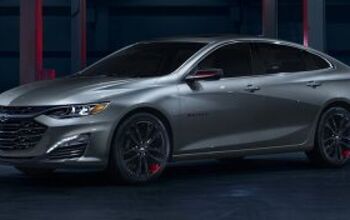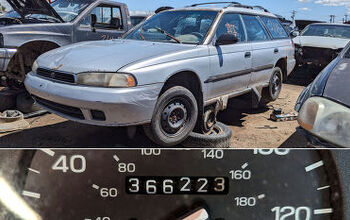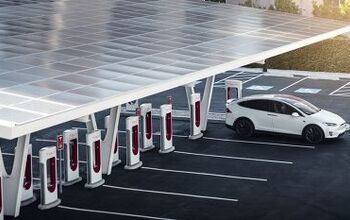There Are Hardly Any Chevrolet Impala Buyers, But The Few Remaining Impala Buyers Are Willing To Pay
We knew General Motors’ strategy for the tenth-generation Chevrolet Impala would be different when the big sedan was launched in 2013. No longer intended to be the fleet queen and a hugely discounted showroom sedan, the tenth-gen Impala moved upmarket.
Consequently, sales decreased, and did so in dramatic fashion. The Impala’s U.S. volume in 2014 was down by more than half compared with 2007 output. Sales continued to fall, with the Impala’s 2016 calendar year result of 97,006 U.S. sales representing the sixth consecutive year of decline.
The Impala’s numbers are getting lower. Much lower. After averaging more than 8,000 monthly Impala sales in 2016 and nearly 10,000 per month as recently as 2015, Impala volume has cratered in early 2017. Only 3,213 Impalas were sold in the United States in April 2017, down 73 percent compared with the Impala’s April average over the last five years.
But don’t assume the scarcity of Impala sales will translate to an abundance of deals at your local Chevrolet dealer. Impalas are thin on the ground, and GM isn’t playing games with incentives.
“Many of our competitors are building large cars for practice. We are building them for profit,” GM spokesperson Jim Cain (no relation) told TTAC yesterday.
Rather than chasing volume with the kinds of significant discounts FCA and Ford are using to move Chargers, 300s, and Tauruses, GM is attempting to protect residual values and thereby improve customer satisfaction in the long run.
This means the Impala is nowhere near as common today as it once was, not even remotely as common this year as last. Among mainstream brand full-size cars, the Impala’s market share shrunk from 23 percent in 2016’s first four months to 19 percent this year. The Impala was easily the segment leader at this time last year; now it’s 4,000 sales back of the Dodge Charger.
But according to J.D. Power PIN data obtained by TTAC, there are key differences.
As a percentage of their average transaction prices, incentives on the Dodge Charger and Chrysler 300 in April stood at 21 percent and 31 percent, respectively. The Impala’s average incentive as a percentage of its April average transaction price was just 12 percent. The new Buick LaCrosse, which is quickly becoming a truly uncommon car, was incentivized to the tune of just 13 percent. In the large car segment, only the Toyota Avalon’s 7-percent average incentive as a percentage of ATP was lower.
Moreover, the Impala’s average transaction prices are rising. Year-to-date, the few Impalas that are leaving Chevrolet showrooms are $600 more costly than they were a year ago. In the full-size segment, only the LaCrosse, Avalon, and Impala have seen average transaction prices rise. The Nissan Maxima, Ford Taurus, and Chrysler 300 have all seen their ATPs fall by more than $1,000.
Aside from the fresh-faced Maxima, newly launched for the 2016 model year, those cars are also suffering from declining sales. (Maxima volume is up 2 percent so far this year.) But their declines are not as severe as those experienced by the Impala and LaCrosse.
Meanwhile, the inventory glut that plagues GM, and GM’s car division in particular, is not a problem that involves the Impala. According to Automotive News, GM has just a 19-day supply of Impalas in an industry that now has a 73-day supply of new vehicles.
Timothy Cain is the founder of GoodCarBadCar.net, which obsesses over the free and frequent publication of U.S. and Canadian auto sales figures. Follow on Twitter @timcaincars.
More by Timothy Cain
Latest Car Reviews
Read moreLatest Product Reviews
Read moreRecent Comments
- Rick T. "If your driving conditions include near-freezing temps for a few months of the year, seek out a set of all-seasons. But if sunshine is frequent and the spectre of 60F weather strikes fear into the hearts of your neighbourhood, all-seasons could be a great choice." So all-seasons it is, apparently!
- 1995 SC Should anyone here get a wild hair and buy this I have the 500 dollar tool you need to bleed the rear brakes if you have to crack open the ABS. Given the state you will. I love these cars (obviously) but trust me, as an owner you will be miles ahead to shell out for one that was maintained. But properly sorted these things will devour highway miles and that 4.6 will run forever and should be way less of a diva than my blown 3.8 equipped one. (and forget the NA 3.8...140HP was no match for this car).As an aside, if you drive this you will instantly realize how ergonomically bad modern cars are.These wheels look like the 17's you could get on a Fox Body Cobra R. I've always had it in the back of my mind to get a set in the right bolt pattern so I could upgrade the brakes but I just don't want to mess up the ride. If that was too much to read, from someone intamately familiar with MN-12's, skip this one. The ground effects alone make it worth a pass. They are not esecially easy to work on either.
- Macca This one definitely brings back memories - my dad was a Ford-guy through the '80s and into the '90s, and my family had two MN12 vehicles, a '93 Thunderbird LX (maroon over gray) purchased for my mom around 1995 and an '89 Cougar LS (white over red velour, digital dash) for my brother's second car acquired a year or so later. The Essex V6's 140 hp was wholly inadequate for the ~3,600 lb car, but the look of the T-Bird seemed fairly exotic at the time in a small Midwest town. This was of course pre-modern internet days and we had no idea of the Essex head gasket woes held in store for both cars.The first to grenade was my bro's Cougar, circa 1997. My dad found a crate 3.8L and a local mechanic replaced it - though the new engine never felt quite right (rough idle). I remember expecting something miraculous from the new engine and then realizing that it was substandard even when new. Shortly thereafter my dad replaced the Thunderbird for my mom and took the Cougar for a new highway commute, giving my brother the Thunderbird. Not long after, the T-Bird's 3.8L V6 also suffered from head gasket failure which spelled its demise again under my brother's ownership. The stately Cougar was sold to a family member and it suffered the same head gasket fate with about 60,000 miles on the new engine.Combine this with multiple first-gen Taurus transmission issues and a lemon '86 Aerostar and my dad's brand loyalty came to an end in the late '90s with his purchase of a fourth-gen Maxima. I saw a mid-90s Thunderbird the other day for the first time in ages and it's still a fairly handsome design. Shame the mechanicals were such a letdown.
- FreedMike It's a little rough...😄
- Rochester Always loved that wrap-around cockpit interior. The rest of this car, not so much. Between the two, it was always the mid-90's Cougar that caught my attention.



































Comments
Join the conversation
I live in DFW with the highest volume chevy dealer in the country 10 miles from my house. I just heard an ad on the radio, they have 173 impalas in stock at 30% off.
We've had two of the new Impalas in our stable at home, and I just LOVED them both. Seriously. Both were LTZs. The first was the 4-cylinder and I remember thinking that all it needed was the V6 because it lacked maybe 50 ft-lbs of torque in my estimation. Then, we got the V6 and ironically I found myself missing the 4-cylinder because it handled so much better! This is actually the car I recommend to people, and everyone who I gave a ride to in a new Impala came away impressed - even Camcord owners.